Effect of Microstructure and Hardness on Cavitation Erosion and Dry Sliding Wear of HVOF Deposited CoNiCrAlY, NiCoCrAlY and NiCrMoNbTa Coatings
Abstract
1. Introduction
2. Materials and Methods
2.1. Materials
2.2. Research Methodology
3. Results and Discussion
3.1. Microstructure and Coatings Properties
3.2. Tribological Testing
3.3. Cavitation Erosion (CE) Resistance
4. Conclusions
- −
- The coatings present increasing resistance to both wear and cavitation erosion in the following order: NiCoCrAlY < CoNiCrAlY < NiCrMoNbTa.
- −
- The NiCrMoNbTa and CoNiCrAlY coatings’ microstructure is dominated by a single-phase matrix and presents mean hardness of 342 HV0.1 and 365 HV0.1, respectively. Even though the NiCoCrAlY coating presents the highest mean hardness (393 HV0.1), it shows the worst tribological and cavitation erosion performance. The differences in microstructure of investigated coatings affect the wear and cavitation erosion performance more than the hardness itself.
- −
- Superior sliding wear behaviour, i.e., lowest coefficient of friction and wear factor K, was noted for NiCrMoNbTa coatings. This coating presents abrasive grooving wear, adhesive smearing, and fatigue of oxidised wear products, while the NiCoCrAlY wear mechanism relies mainly on the abrasive grooving and oxidation of wear products which results in the highest wear rate and COF.
- −
- The coatings’ microstructure affects mechanical properties and determines the CE behaviour. Cavitation erosion is initiated at microstructure discontinuities and ends up with severe surface pitting. MCrAlY coatings present semi brittle behavior, while NiCrMoNbTa coating shows ductile mode and lesser surface pitting.
- −
- In the case of cavitation erosion, the hardness correlates well with the erosion results, i.e., softer coatings present higher deformability and display better performance under cavitation load by absorbing it for plastic deformation. Thus, NiCrMoNbTa coatings present the lowest cavitation erosion rate.
Author Contributions
Funding
Institutional Review Board Statement
Informed Consent Statement
Data Availability Statement
Acknowledgments
Conflicts of Interest
References
- Łatka, L. Thermal barrier coatings manufactured by suspension plasma spraying—A review. Adv. Mat. Sci. 2018, 18, 95–117. [Google Scholar] [CrossRef]
- Winnicki, M. Advanced Functional Metal-Ceramic and Ceramic Coatings Deposited by Low-Pressure Cold Spraying: A Review. Coatings 2021, 11, 1044. [Google Scholar] [CrossRef]
- Łatka, L.; Szala, M.; Macek, W.; Branco, R. Mechanical Properties and Sliding Wear Resistance of Suspension Plasma Sprayed YSZ Coatings. Adv. Sci. Technol. Res. J. 2020, 14, 307–314. [Google Scholar] [CrossRef]
- Han, Y.; Zhu, Z.; Zhang, B.; Chu, Y.; Zhang, Y.; Fan, J. Effects of process parameters of vacuum pre-oxidation on the microstructural evolution of CoCrAlY coating deposited by HVOF. J. Alloys Compd. 2018, 735, 547–559. [Google Scholar] [CrossRef]
- Davis, J.R. Handbook of Thermal Spray Technology; ASM International: Russell Township, OH, USA, 2004. [Google Scholar]
- Łatka, L.; Pawłowski, L.; Winnicki, M.; Sokołowski, P.; Małachowska, A.; Kozerski, S. Review of functionally graded thermal sprayed coatings. Appl. Sci. 2020, 10, 5153. [Google Scholar] [CrossRef]
- Czupryński, A. Flame spraying of aluminum coatings reinforced with particles of carbonaceous materials as an alternative for laser cladding technologies. Materials 2019, 12, 3467. [Google Scholar] [CrossRef]
- Jonda, E.; Łatka, L. Comparative analysis of mechanical properties of WC-based cermet Coatings sprayed by HVOF onto AZ31 magnesium alloy substrates. Adv. Sci. Technol. Res. J. 2021, 15, 57–64. [Google Scholar] [CrossRef]
- Górka, J.; Czupryński, A. The properties and structure of arc sprayed coatings alloy of Fe-Cr-Ti-Si-Mn. Int. J. Mod. Manuf. Technol. 2016, 8, 35–40. [Google Scholar]
- Michalak, M.; Sokołowski, P.; Szala, M.; Walczak, M.; Łatka, L.; Toma, F.-L.; Björklund, S. Wear behavior analysis of Al2O3 coatings manufactured by APS and HVOF spraying processes using powder and suspension feedstocks. Coatings 2021, 11, 879. [Google Scholar] [CrossRef]
- Mahade, S.; Mulone, A.; Björklund, S.; Klement, U.; Joshi, S. Investigating load-dependent wear behavior and degradation mechanisms in Cr3C2–NiCr coatings deposited by HVAF and HVOF. J. Mater. Res. Technol. 2021, 15, 4595–4609. [Google Scholar] [CrossRef]
- Daniel, J.; Grossman, J.; Houdková, Š.; Bystrianský, M. Impact wear of the protective Cr3C2-based HVOF-sprayed coatings. Materials 2020, 13, 2132. [Google Scholar] [CrossRef] [PubMed]
- Bolelli, G.; Vorkötter, C.; Lusvarghi, L.; Morelli, S.; Testa, V.; Vaßen, R. Performance of wear resistant MCrAlY coatings with oxide dispersion strengthening. Wear 2020, 444–445, 203116. [Google Scholar] [CrossRef]
- Dorfman, M.R. Thermal spray coatings. In Handbook of Environmental Degradation of Materials, 1st ed.; Kutz, M., Ed.; Elsevier: Amsterdam, The Netherlands, 2005; pp. 469–488. [Google Scholar]
- Mayer, A.R.; Bertuol, K.; Siqueira, I.B.A.F.; Chicoski, A.; Váz, R.F.; de Sousa, M.J.; Pukasiewicz, A.G.M. Evaluation of cavitation/corrosion synergy of the Cr3C2-25NiCr coating deposited by HVOF process. Ultrason. Sono-Chem. 2020, 69, 105271. [Google Scholar] [CrossRef] [PubMed]
- Ronzani, A.G.; Pukasiewicz, A.G.M.; da Silva Custodio, R.M.; de Vasconcelos, G.; de Oliveira, A.C.C. Cavitation resistance of tungsten carbide applied on AISI 1020 steel by HVOF and remelted with CO2 laser. J. Braz. Soc. Mech. Sci. Eng. 2020, 42, 316. [Google Scholar] [CrossRef]
- Taylor, T.A.; Overs, M.P.; Gill, B.J.; Tucker, R.C. Experience with MCrAl and thermal barrier coatings produced via inert gas shrouded plasma deposition. J. Vac. Sci. Technol. A Vac. Surf. Film. 1985, 3, 2526–2531. [Google Scholar] [CrossRef]
- Soltani, R.; Samadi, H.; Garcia, E.; Coyle, T.W. Development of Alternative Thermal Barrier Coatings for Diesel Engines; SAE Technical Paper 2005-01-0650; SAE International: Warrendale, PA, USA, 2005. [Google Scholar] [CrossRef]
- Chun, G.; Jianmin, C.; Rungang, Y.; Jiansong, Z. Microstructure and high temperature wear resistance of laser cladding NiCoCrAlY/ZrB2 coating. Rare Met. Mater. Eng. 2013, 42, 1547–1551. [Google Scholar] [CrossRef]
- Wang, W.; Li, J.; Ge, Y.; Kong, D. Structural characteristics and high-temperature tribological behaviors of laser cladded NiCoCrAlY–B4C composite coatings on Ti6Al4V alloy. Trans. Nonferrous Met. Soc. China 2021, 31, 2729–2739. [Google Scholar] [CrossRef]
- Pereira, J.; Zambrano, J.; Licausi, M.; Tobar, M.; Amigó, V. Tribology and high temperature friction wear behavior of MCrAlY laser cladding coatings on stainless steel. Wear 2015, 330–331, 280–287. [Google Scholar] [CrossRef]
- Cao, S.; Ren, S.; Zhou, J.; Yu, Y.; Wang, L.; Guo, C.; Xin, B. Influence of composition and microstructure on the tribological property of SPS sintered MCrAlY alloys at elevated temperatures. J. Alloy. Compd. 2018, 740, 790–800. [Google Scholar] [CrossRef]
- Zakrzewska, D.E.; Krella, A.K. Cavitation erosion resistance influence of material properties. Adv. in Mater. Sci. 2019, 19, 18–34. [Google Scholar] [CrossRef]
- Vuoristo, P. Thermal Spray Coating Processes. In Comprehensive Materials Processing, 1st ed.; Hashmi, S., Ed.; Elsevier: Amsterdam, The Netherlands, 2014; Volume 4. [Google Scholar]
- Oksa, M.; Turunen, E.; Suhonen, T.; Varis, T.; Hannula, S.P. Optimization and characterization of high velocity oxy-fuel sprayed coatings: Techniques, materials, and applications. Coatings 2011, 1, 17–52. [Google Scholar] [CrossRef]
- Tzanakis, I.; Bolzoni, L.; Eskin, D.G.; Hadfield, M. Evaluation of cavitation erosion behavior of commercial steel grades used in the design of fluid machinery. Metall. Mater. Trans. A 2017, 48, 2193–2206. [Google Scholar] [CrossRef]
- Hattori, S.; Mikami, N. Cavitation erosion resistance of Stellite alloy weld overlays. Wear 2009, 267, 1954–1960. [Google Scholar] [CrossRef]
- Szala, M.; Chocyk, D.; Skic, A.; Kamiński, M.; Macek, W.; Turek, M. Effect of nitrogen ion implantation on the cavitation erosion resistance and cobalt-based solid solution phase transformations of HIPed Stellite 6. Materials 2021, 14, 2324. [Google Scholar] [CrossRef] [PubMed]
- Jonda, E.; Łatka, L.; Pakieła, W. Comparison of different cermet coatings sprayed on magnesium alloy by HVOF. Materials 2021, 14, 1594. [Google Scholar] [CrossRef] [PubMed]
- Caccese, V.; Light, K.H.; Berube, K.A. Cavitation erosion resistance of various material systems. Ships Offshore Struct. 2006, 1, 309–322. [Google Scholar] [CrossRef]
- Grist, E. Cavitation and the Centrifugal Pump: A Guide for Pump Users; CRC Press: Boca Raton, FL, USA, 1998. [Google Scholar]
- Szala, M.; Walczak, M.; Hejwowski, T. Factors influencing cavitation erosion of NiCrSiB hardfacings deposited by oxy-acetylene powder welding on grey cast iron. Adv. Sci. Technol. Res. J. 2021, 15, 376–386. [Google Scholar] [CrossRef]
- Lin, J.; Wang, Z.; Lin, P.; Cheng, J.; Zhang, X.; Hong, S. Microstructure and cavitation erosion behavior of FeNiCrBSiNbW coating prepared by twin wires arc spraying process. Surf. Coat. Technol. 2014, 240, 432–436. [Google Scholar] [CrossRef]
- Kekes, D.; Psyllaki, P.; Vardavoulias, M.; Vekinis, G. Wear micro-mechanisms of composite WC-Co/Cr-NiCrFeBSiC coatings. Part II: Cavitation erosion. Tribol. Ind. 2014, 36, 375–383. [Google Scholar]
- Zheng, J.; Yang, D.; Gao, Y. Effect of vacuum heat treatment on the high-temperature oxidation resistance of NiCrAlY coating. Coatings 2020, 10, 1–12. [Google Scholar] [CrossRef]
- Sadeghimeresht, E.; Reddy, L.; Hussain, T.; Huhtakangas, M.; Markocsan, N.; Joshi, S. Influence of KCl and HCl on high temperature corrosion of HVAF-sprayed NiCrAlY and NiCrMo coatings. Mater. Des. 2018, 148, 17–29. [Google Scholar] [CrossRef]
- Singh, G.; Bala, N.; Chawla, V. High Temperature oxidation behaviour and characterization of NiCrAlY-B4C coatings deposited by HVOF. Mater. Res. Express 2019, 6, 086436. [Google Scholar] [CrossRef]
- Szala, M.; Walczak, M.; Łatka, L.; Gancarczyk, K.; Özkan, D. Cavitation erosion and sliding wear of MCrAlY and NiCrMo coatings deposited by HVOF thermal spraying. Adv. Mater. Sci. 2020, 20, 26–38. [Google Scholar] [CrossRef]
- Ciubotariu, C.-R.; Secosan, E.; Marginean, G.; Frunzaverde, D.; Campian, V.C. Experimental study regarding the cavitation and corrosion resistance of Stellite 6 and self-fluxing remelted coatings. Strojniški Vestnik—J. Mech. Eng. 2016, 62, 154–162. [Google Scholar] [CrossRef][Green Version]
- Budzyński, P.; Kamiński, M.; Turek, M.; Wiertel, M. Impact of nitrogen and manganese ion implantation on the tribological properties of Stellite 6 alloy. Wear 2020, 456–457, 203360. [Google Scholar] [CrossRef]
- Varis, T.; Suhonen, T.; Laakso, J.; Jokipii, M.; Vuoristo, P. Evaluation of residual stresses and their influence on cavitation erosion resistance of high kinetic HVOF and HVAF-sprayed WC-CoCr coatings. J. Therm. Spray Technol. 2020, 29, 1365–1381. [Google Scholar] [CrossRef]
- Ding, X.; Ke, D.; Yuan, C.; Ding, Z.; Cheng, X. Microstructure and cavitation erosion resistance of HVOF deposited WC-Co coatings with different sized WC. Coatings 2018, 8, 307. [Google Scholar] [CrossRef]
- Huang, Q.; Qin, E.; Li, W.; Wang, B.; Pan, C.; Wu, S. The cavitation resistance of WC-CoCr cermet coating deposited by HVOF for hydraulic application. J. Therm. Spray Eng. 2020, 3, 68–73. [Google Scholar] [CrossRef]
- Walczak, M.; Szala, M. Effect of shot peening on the surface properties, corrosion and wear performance of 17-4PH steel produced by DMLS additive manufacturing. Archiv. Civ. Mech. Eng. 2021, 21, 157. [Google Scholar] [CrossRef]
- Łatka, L.; Michalak, M.; Szala, M.; Walczak, M.; Sokołowski, P.; Ambroziak, A. Influence of 13 wt.% TiO2 content in alumina-titania powders on microstructure, sliding wear and cavitation erosion resistance of APS sprayed coatings. Surf. Coat. Technol. 2021, 410, 126979. [Google Scholar] [CrossRef]
- Drozd, K.; Walczak, M.; Szala, M.; Gancarczyk, K. Tribological behavior of AlCrSiN-coated tool steel K340 versus popular tool steel grades. Materials 2020, 13, 4895. [Google Scholar] [CrossRef]
- ASTM International. ASTM G32-16 Standard Test Method for Cavitation Erosion Using Vibratory pparatus; ASTM International: West Conshohocken, PA, USA, 2016. [Google Scholar]
- Szala, M.; Walczak, M. Cavitation erosion and sliding wear resistance of HVOF coatings. Weld. Technol. Rev. 2018, 90. [Google Scholar] [CrossRef]
- Szala, M.; Łatka, L.; Walczak, M.; Winnicki, M. Comparative study on the cavitation erosion and sliding wear of cold-sprayed Al/Al2O3 and Cu/Al2O3 coatings, and stainless steel, aluminium alloy, copper and brass. Metals 2020, 10, 856. [Google Scholar] [CrossRef]
- Szala, M.; Świetlicki, A.; Sofińska-Chmiel, W. Cavitation erosion of electrostatic spray polyester coatings with different surface finish. Bull. Pol. Acad. Sci. Tech. Sci. 2021, 69, e137519. [Google Scholar] [CrossRef]
- Rajasekaran, B.; Mauer, G.; Vaßen, R. Enhanced characteristics of HVOF-sprayed MCrAlY bond coats for TBC applications. J. Therm. Spray Tech. 2011, 20, 1209–1216. [Google Scholar] [CrossRef]
- Yuan, K.; Yu, Y.; Wen, J.-F. A study on the thermal cyclic behavior of thermal barrier coatings with different MCrAlY roughness. Vacuum 2017, 137, 72–80. [Google Scholar] [CrossRef]
- Oladijo, O.P.; Collieus, L.L.; Obadele, B.A.; Akinlabi, E.T. Correlation between residual stresses and the tribological behaviour of Inconel 625 coatings. Surf. Coat. Technol. 2021, 419, 127288. [Google Scholar] [CrossRef]
- Al-Fadhli, H.Y.; Stokes, J.; Hashmi, M.S.J.; Yilbas, B.S. The erosion-corrosion behaviour of high velocity oxy-fuel (HVOF) thermally sprayed Inconel-625 coatings on different metallic surfaces. Surf. Coat. Technol. 2006, 200, 5782–5788. [Google Scholar] [CrossRef]
- Nowak, W.; Naumenko, D.; Mor, G.; Mor, F.; Mack, D.E.; Vassen, R.; Singheiser, L.; Quadakkers, W.J. Effect of processing parameters on MCrAlY bondcoat roughness and lifetime of APS-TBC systems. Surf. Coat. Technol. 2014, 260, 82–89. [Google Scholar] [CrossRef]
- Saeidi, S.; Voisey, K.T.; McCartney, D.G. Mechanical properties and microstructure of VPS and HVOF CoNiCrAlY coatings. J. Therm. Spray Tech. 2011, 20, 1231–1243. [Google Scholar] [CrossRef]
- Mohammadi, M.; Javadpour, S.; Kobayashi, A.; Jenabali Jahromi, S.A.; Shirvani, K. Thermal shock properties and microstructure investigation of LVPS and HVOF-CoNiCrAlYSi coatings on the IN738LC superalloy. Vacuum 2013, 88, 124–129. [Google Scholar] [CrossRef]
- Fossati, A.; Ferdinando, M.D.; Lavacchi, A.; Scrivani, A.; Giolli, C.; Bardi, U. Improvement of the oxidation resistance of CoNiCrAlY bond coats sprayed by high velocity oxygen-fuel onto nickel superalloy substrate. Coatings 2010, 1, 3–16. [Google Scholar] [CrossRef]
- Abu-warda, N.; Tomás, L.M.; López, A.J.; Utrilla, M.V. High temperature corrosion behavior of Ni and Co base HVOF coatings exposed to NaCl-KCl salt mixture. Surf. Coat. Technol. 2021, 418, 127277. [Google Scholar] [CrossRef]
- Elshalakany, A.B.; Osman, T.A.; Hoziefa, W.; Escuder, A.V.; Amigó, V. Comparative study between high-velocity oxygen fuel and flame spraying using MCrAlY coats on a 304 stainless steel substrate. J. Mater. Res. Technol. 2019, 8, 4253–4263. [Google Scholar] [CrossRef]
- Bai, M.; Song, B.; Reddy, L.; Hussain, T. Preparation of MCrAlY–Al2O3 Composite coatings with enhanced oxidation resistance through a novel powder manufacturing process. J. Therm. Spray Tech. 2019, 28, 433–443. [Google Scholar] [CrossRef]
- Fantozzi, D.; Matikainen, V.; Uusitalo, M.; Koivuluoto, H.; Vuoristo, P. Effect of carbide dissolution on chlorine induced high temperature corrosion of HVOF and HVAF sprayed Cr3C2-NiCrMoNb coatings. J. Therm. Spray Tech. 2018, 27, 220–231. [Google Scholar] [CrossRef]
- Hao, E.; An, Y.; Zhao, X.; Zhou, H.; Chen, J. NiCoCrAlYTa Coatings on nickel-base superalloy substrate: Deposition by high velocity oxy-fuel spraying as well as investigation of mechanical properties and wear resistance in relation to heat-treatment duration. Appl. Surf. Sci. 2018, 462, 194–206. [Google Scholar] [CrossRef]
- Gahr, K.-H.Z. Microstructure and Wear of Materials, 1st ed.; Elsevier: Amsterdam, The Netherlands, 1987. [Google Scholar]
- Brunetti, C.; Belotti, L.P.; Miyoshi, M.H.; Pintaúde, G.; D’Oliveira, A.S.C.M. Influence of Fe on the room and high-temperature sliding wear of NiAl coatings. Surf. and Coat. Technol. 2014, 258, 160–167. [Google Scholar] [CrossRef]
- Jiang, X.; Overman, N.; Smith, C.; Ross, K. Microstructure, hardness and cavitation erosion resistance of different cold spray coatings on stainless steel 316 for hydropower applications. Mater. Today Commun. 2020, 25, 101305. [Google Scholar] [CrossRef]
- Roa, C.V.; Valdes, J.A.; Larrahondo, F.; Rodríguez, S.A.; Coronado, J.J. Comparison of the resistance to cavitation erosion and slurry erosion of four kinds of surface modification on 13-4 Ca6NM hydro-machinery steel. J. Materi Eng. Perform. 2021, 30, 7195–7212. [Google Scholar] [CrossRef]
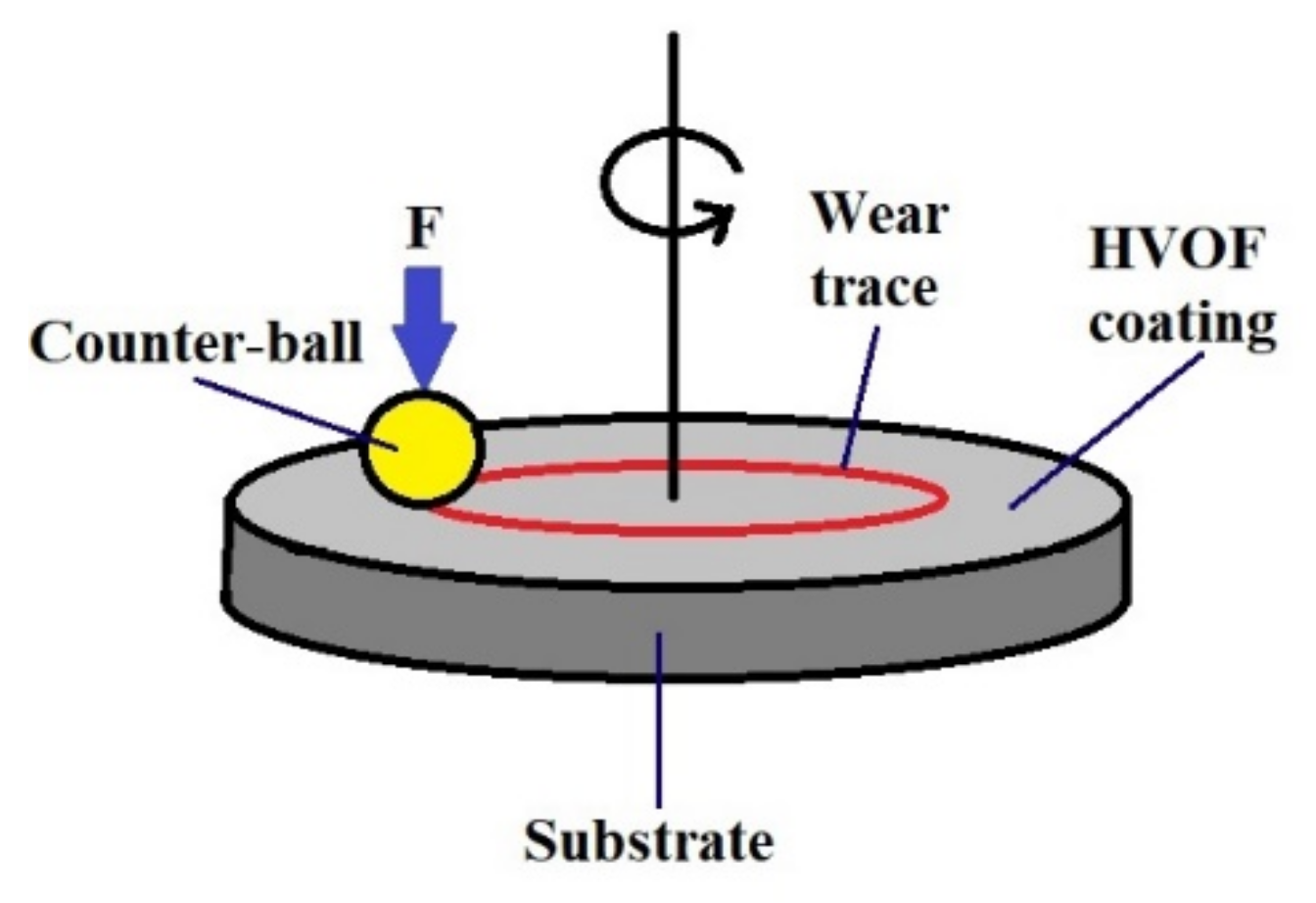
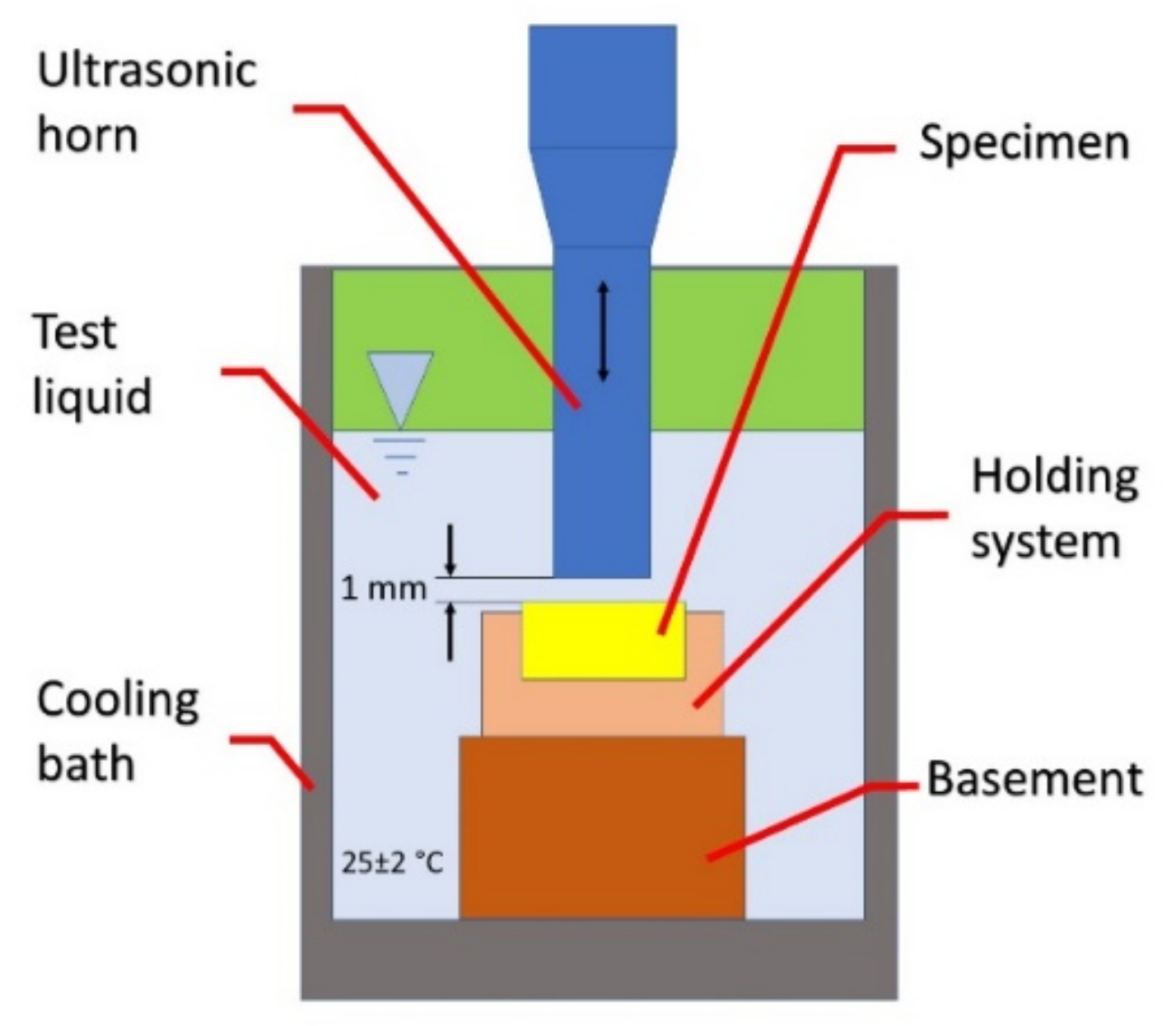
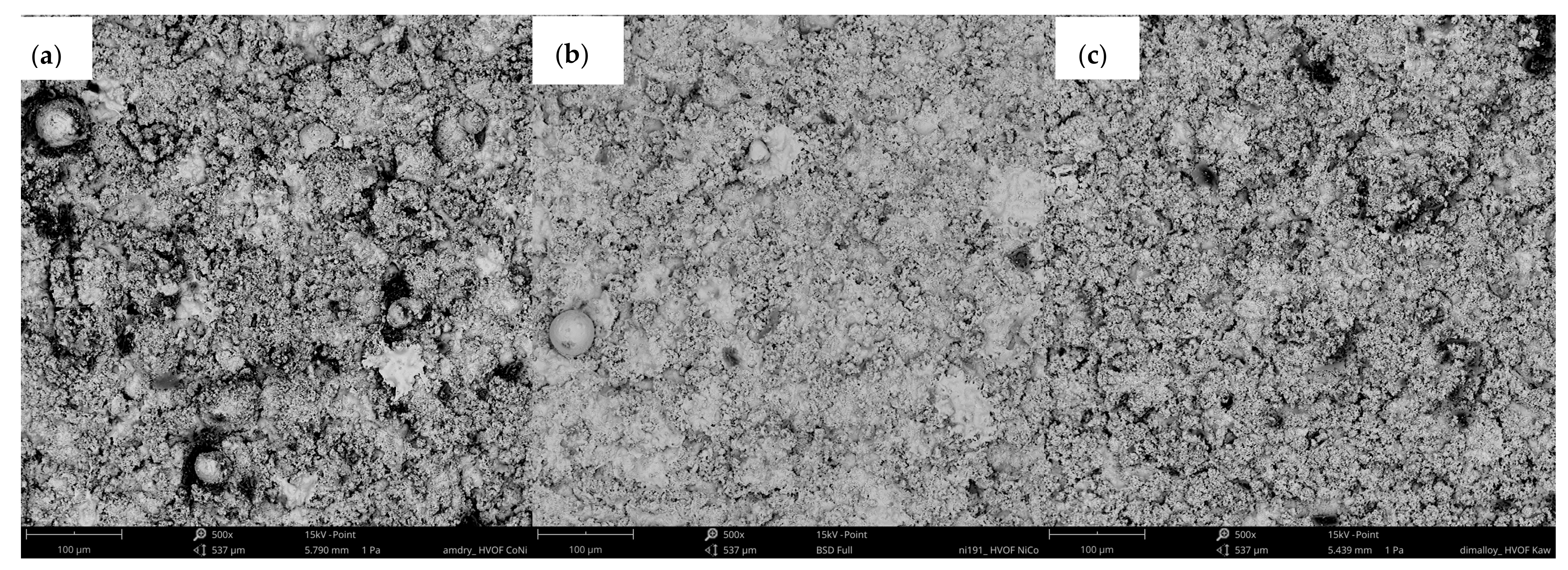
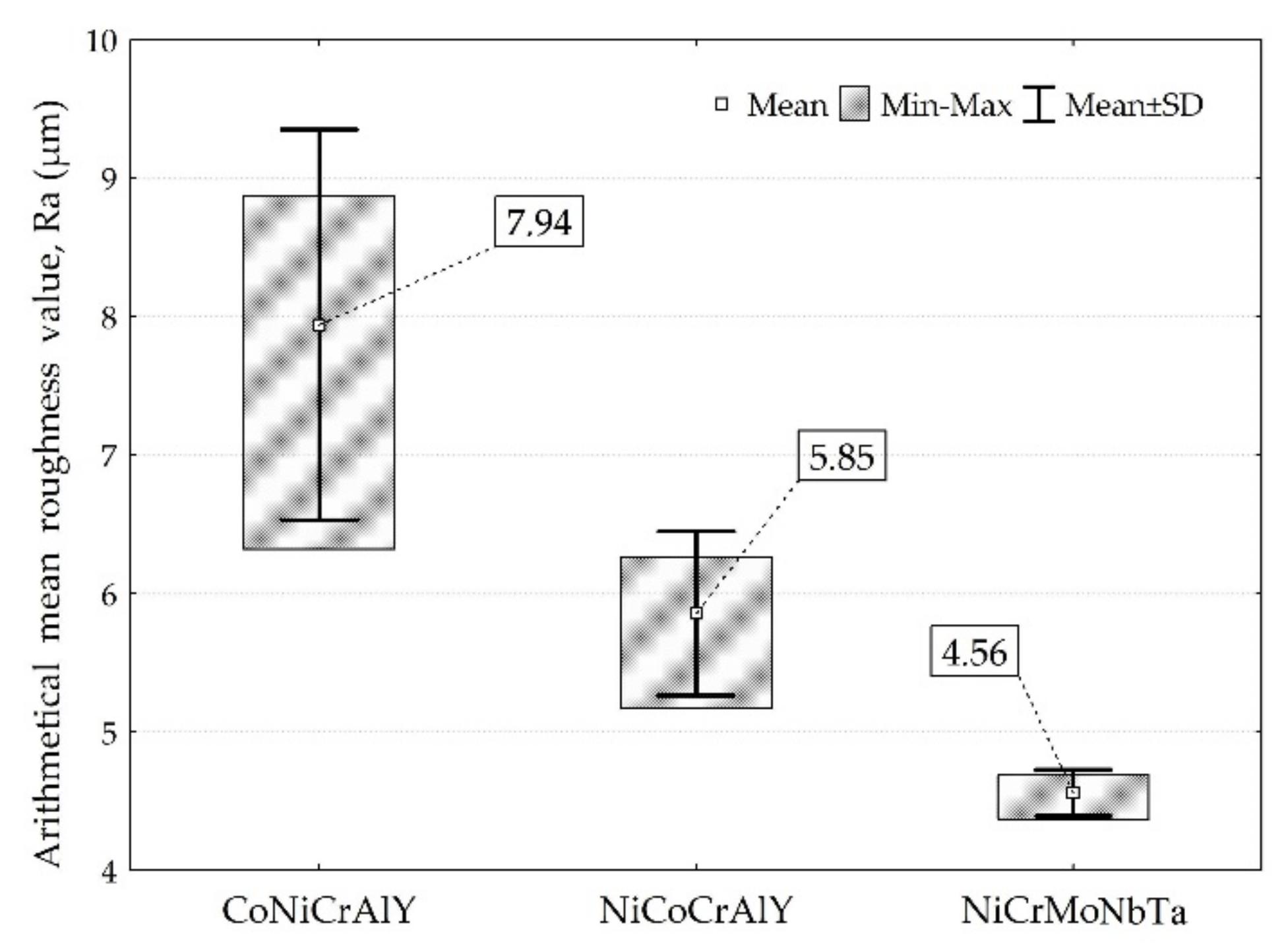

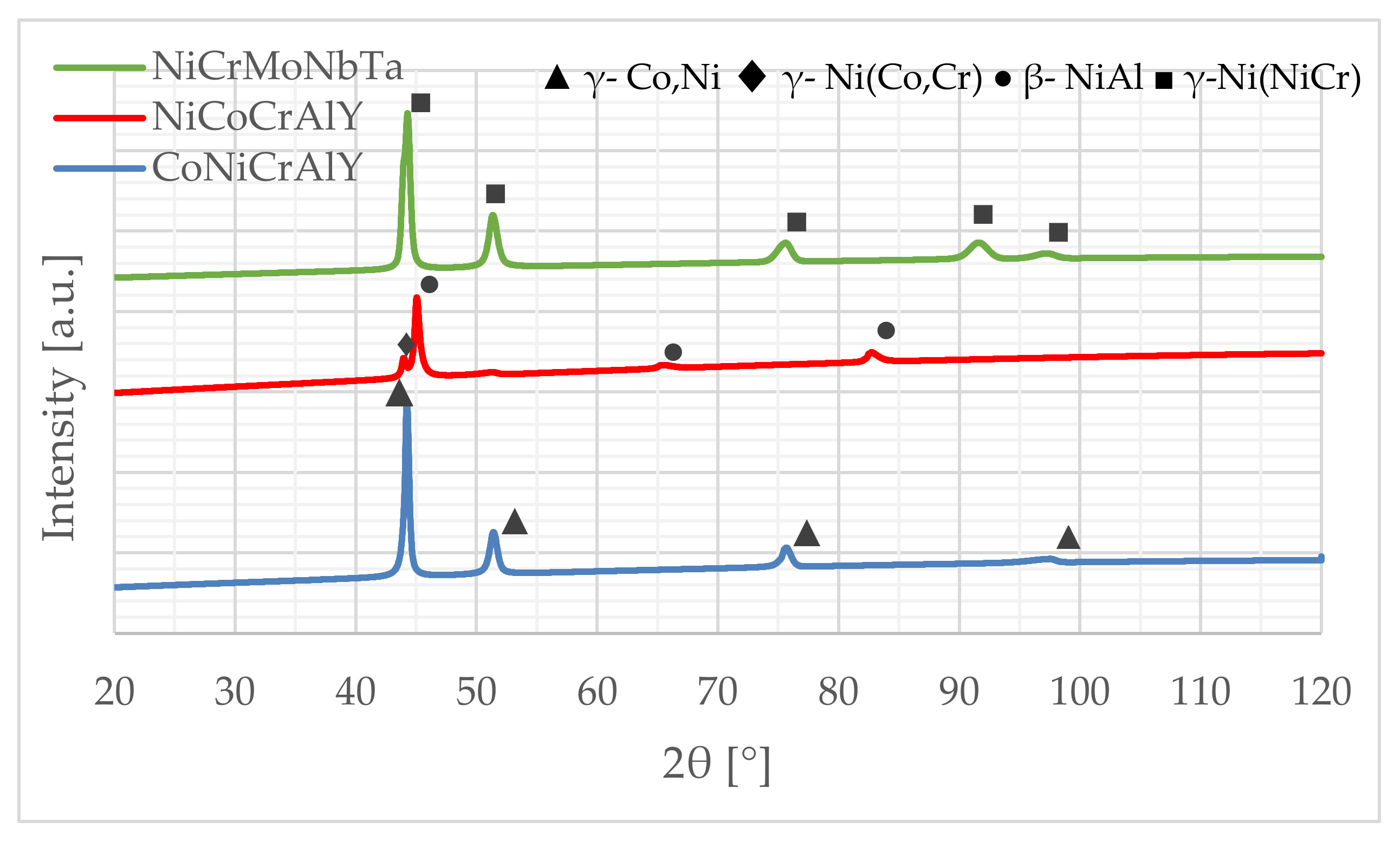
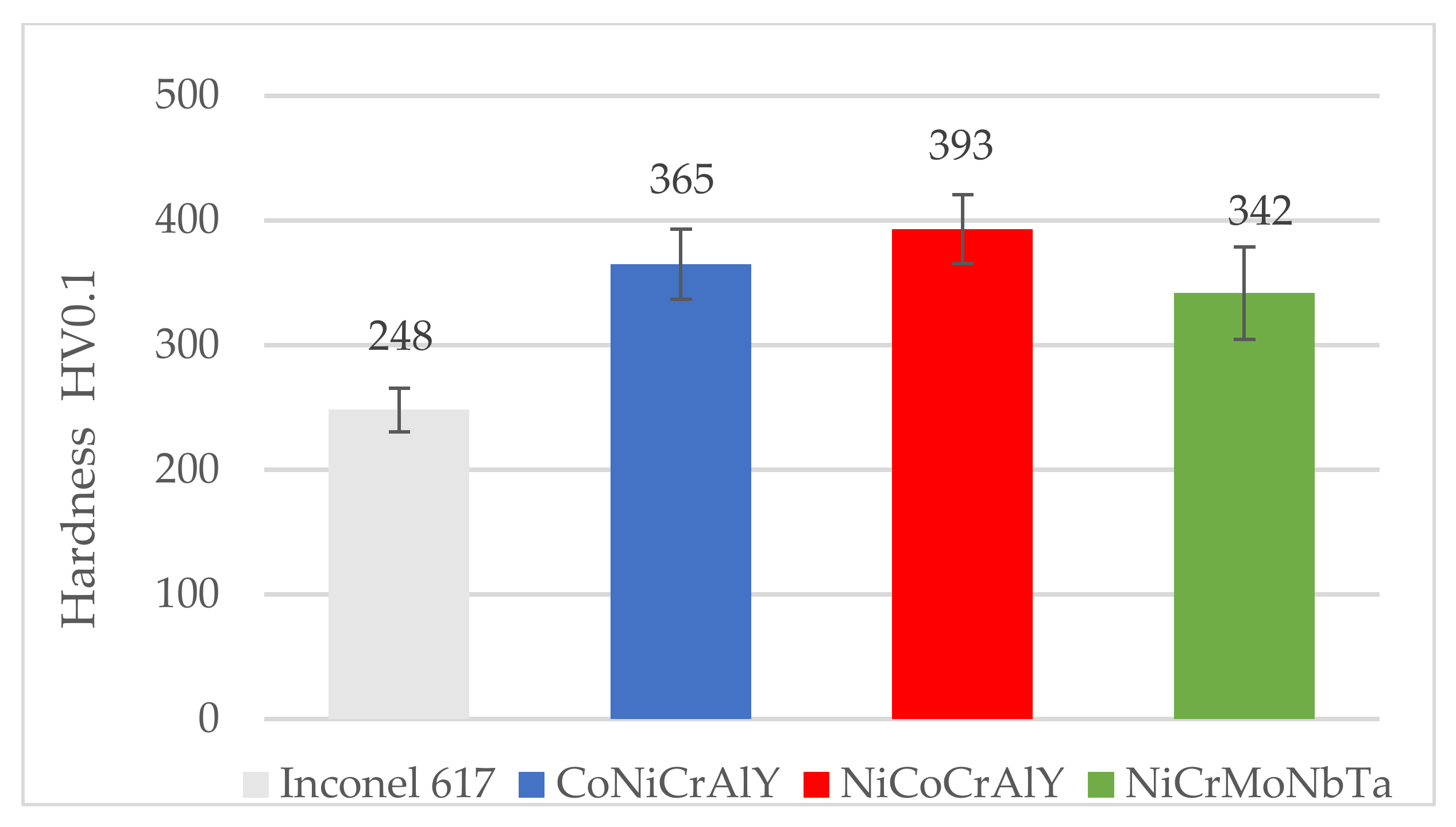
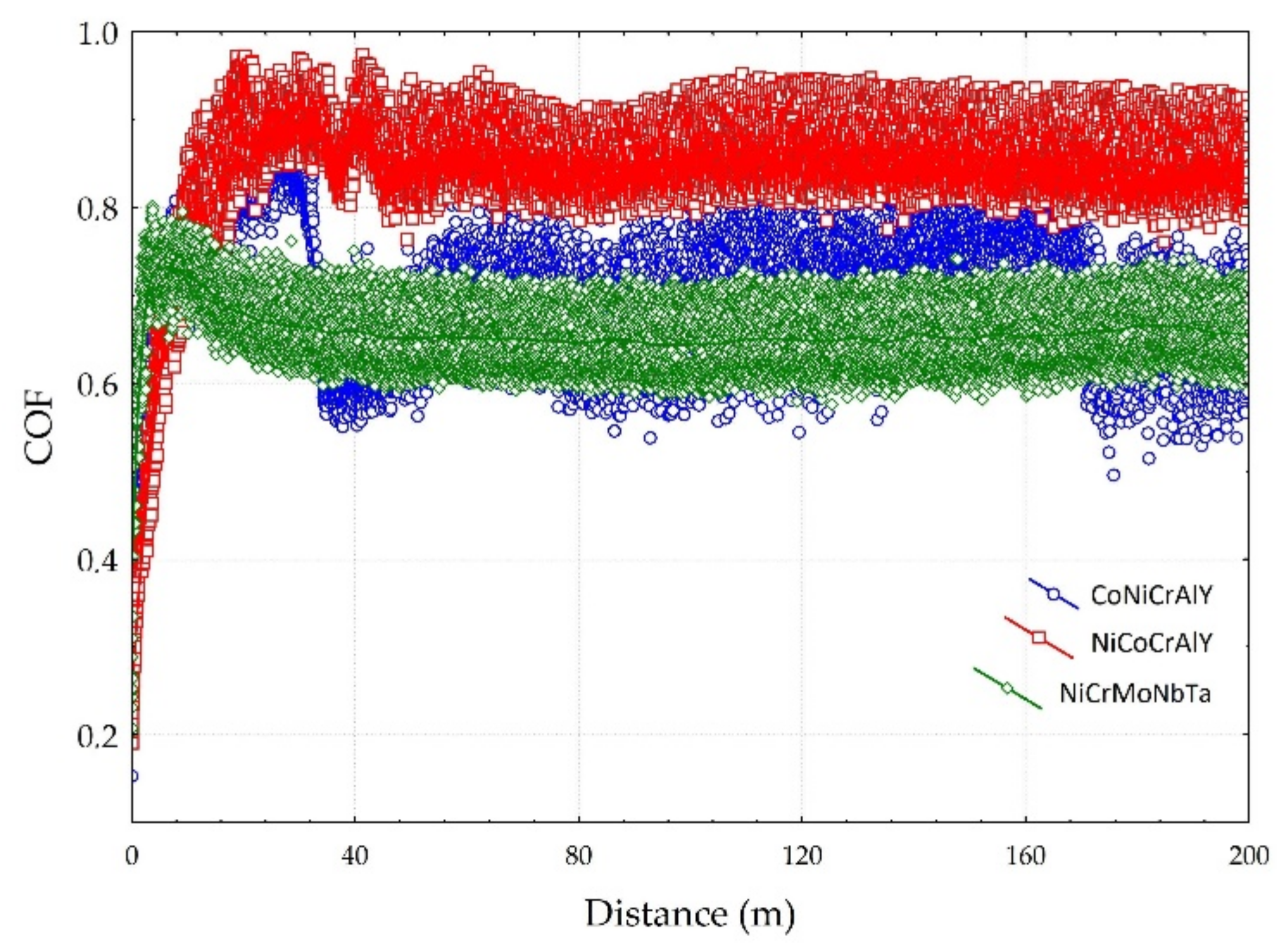


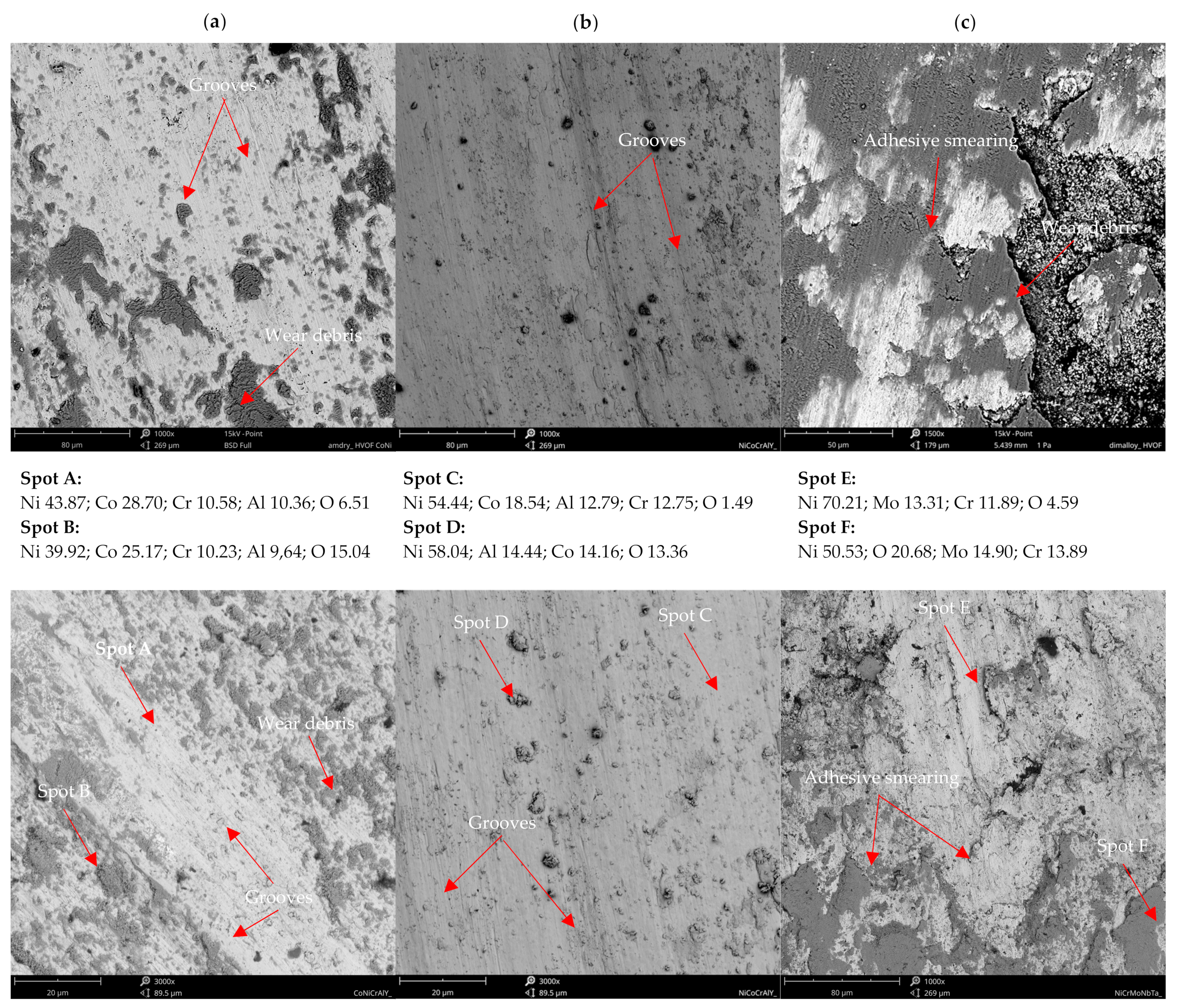
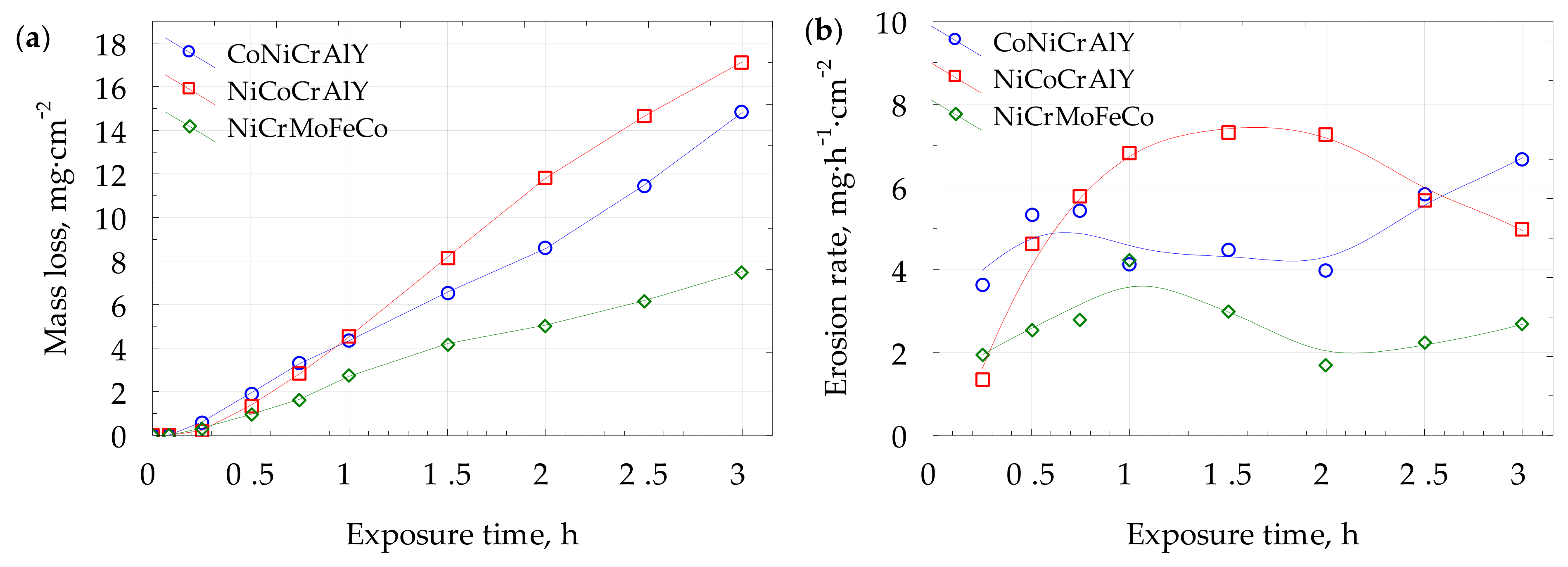
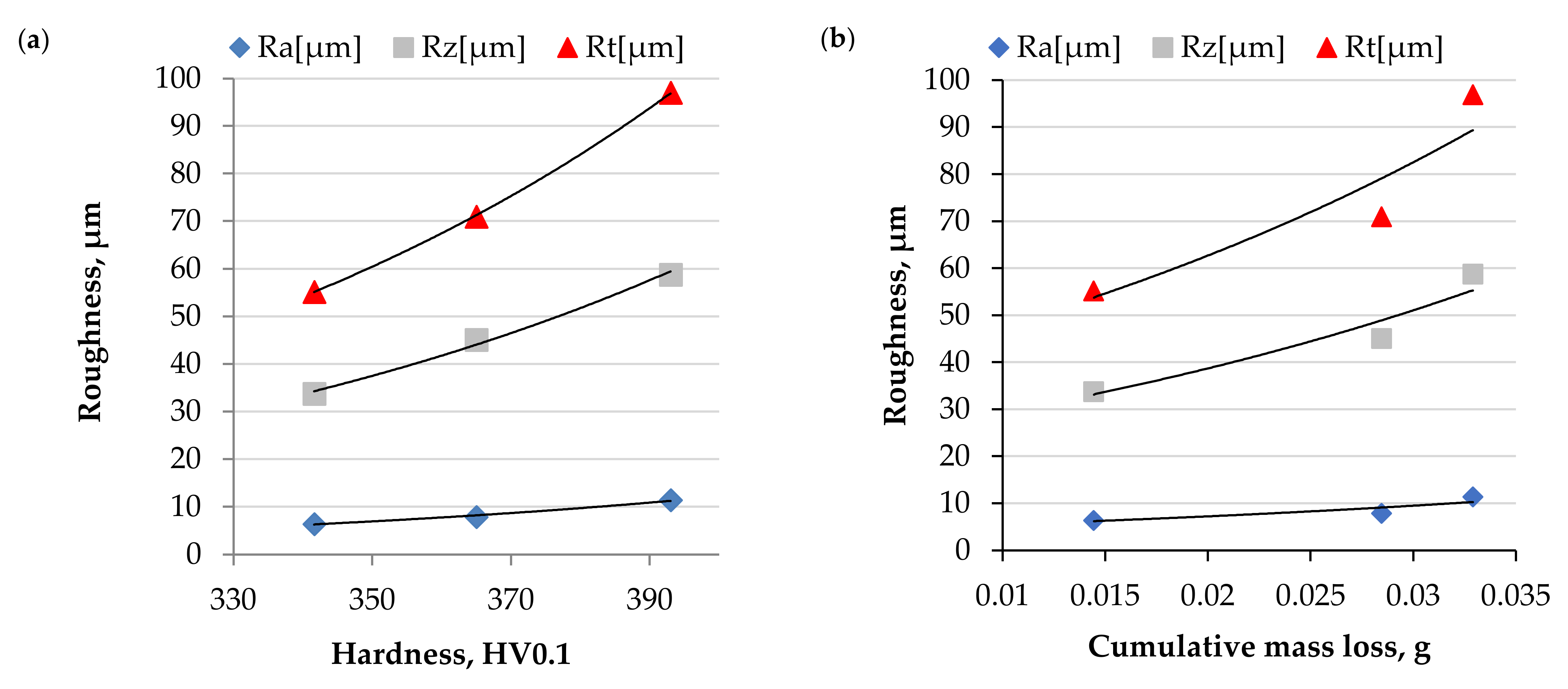
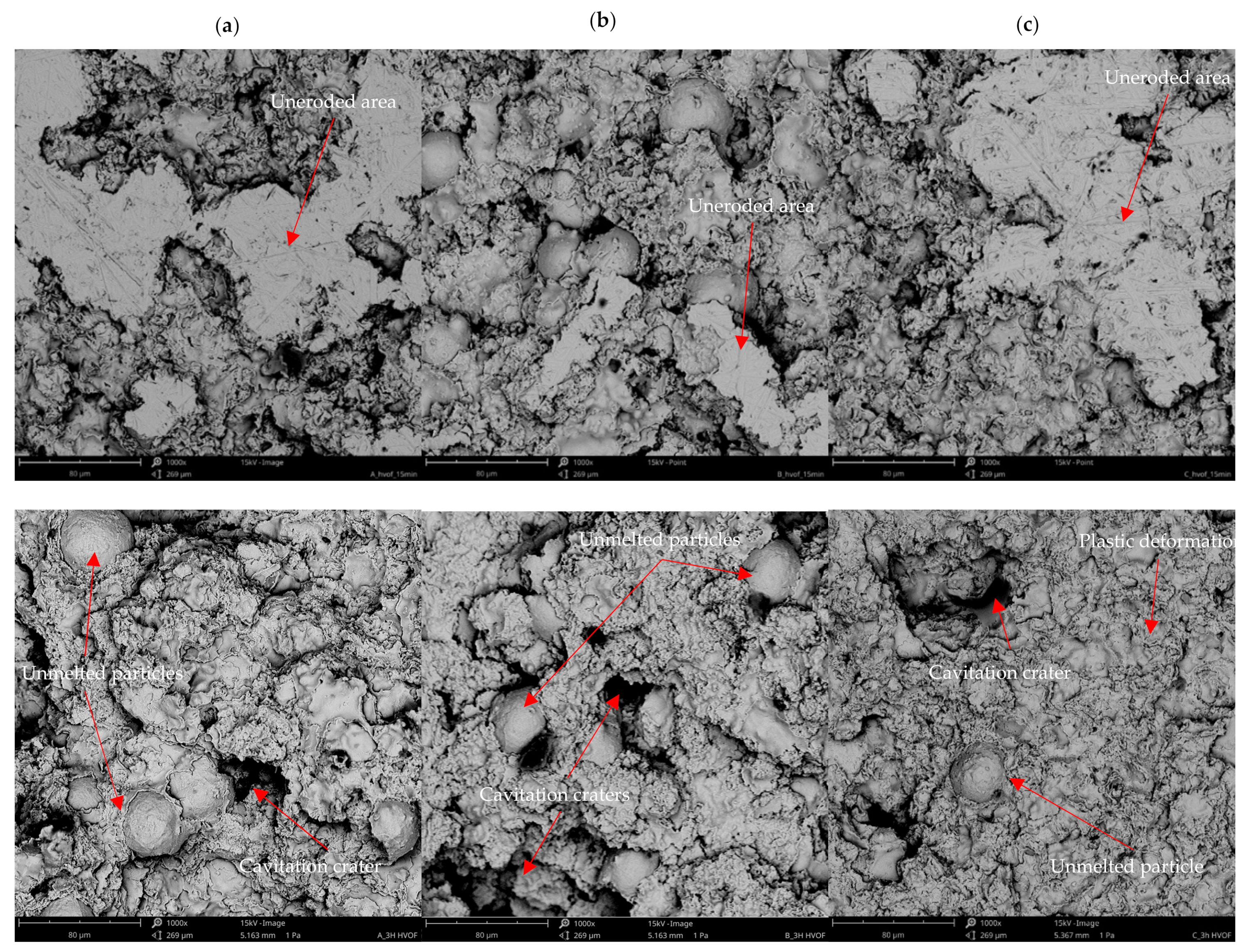

| Ni | Cr | Mo | Cu | Co | C | Mn | Si | S | Fe | Ti | Al | B | |
|---|---|---|---|---|---|---|---|---|---|---|---|---|---|
| Wt.% | 44.5 | 20–24 | 8–10 | 0–0.5 | 10–15 | 0.05–0.15 | 0–1 | 0–1 | 0–0.015 | 0–3 | 0–0.6 | 0.8–1.5 | 0–0.006 |
| CoNiCrAlY | NiCoCrAlY | NiCrMoNbTa | |||
|---|---|---|---|---|---|
| Element | (wt.%) | Element | (wt.%) | Element | (wt.%) |
| Ni | 29.00–35.00 | Ni | Bal. | Ni | Bal. |
| Co | Bal. | Co | 22.00 | Co | - |
| Cr | 18.00–24.00 | Cr | 17.00 | Cr | 21.50 |
| Al | 5.00–11.00 | Al | 12.50 | Al | - |
| Y | 0.10–0.80 | Y | 0.55 | Y | - |
| Mo | - | Mo | - | Mo | 9.00 |
| Nb + Ta | - | Nb + Ta | - | Nb + Ta | 3.70 |
| Fe | - | Fe | - | Fe | 2.50 |
| CoNiCrAlY | NiCoCrAlY | NiCrMoNbTa | |||
|---|---|---|---|---|---|
| Element | (wt.%) | Element | (wt.%) | Element | (wt.%) |
| Ni | 35.15 | Ni | 47.49 | Ni | 64.56 |
| Co | 37.33 | Co | 22.14 | Co | - |
| Cr | 19.83 | Cr | 20.03 | Cr | 18.71 |
| Al | 7.68 | Al | 10.34 | Mo | 9.34 |
| Y | - | Y | - | Nb | 4.32 |
| Ta | 2.81 | ||||
| Fe | 0.25 | ||||
Publisher’s Note: MDPI stays neutral with regard to jurisdictional claims in published maps and institutional affiliations. |
© 2021 by the authors. Licensee MDPI, Basel, Switzerland. This article is an open access article distributed under the terms and conditions of the Creative Commons Attribution (CC BY) license (https://creativecommons.org/licenses/by/4.0/).
Share and Cite
Szala, M.; Walczak, M.; Świetlicki, A. Effect of Microstructure and Hardness on Cavitation Erosion and Dry Sliding Wear of HVOF Deposited CoNiCrAlY, NiCoCrAlY and NiCrMoNbTa Coatings. Materials 2022, 15, 93. https://doi.org/10.3390/ma15010093
Szala M, Walczak M, Świetlicki A. Effect of Microstructure and Hardness on Cavitation Erosion and Dry Sliding Wear of HVOF Deposited CoNiCrAlY, NiCoCrAlY and NiCrMoNbTa Coatings. Materials. 2022; 15(1):93. https://doi.org/10.3390/ma15010093
Chicago/Turabian StyleSzala, Mirosław, Mariusz Walczak, and Aleksander Świetlicki. 2022. "Effect of Microstructure and Hardness on Cavitation Erosion and Dry Sliding Wear of HVOF Deposited CoNiCrAlY, NiCoCrAlY and NiCrMoNbTa Coatings" Materials 15, no. 1: 93. https://doi.org/10.3390/ma15010093
APA StyleSzala, M., Walczak, M., & Świetlicki, A. (2022). Effect of Microstructure and Hardness on Cavitation Erosion and Dry Sliding Wear of HVOF Deposited CoNiCrAlY, NiCoCrAlY and NiCrMoNbTa Coatings. Materials, 15(1), 93. https://doi.org/10.3390/ma15010093








